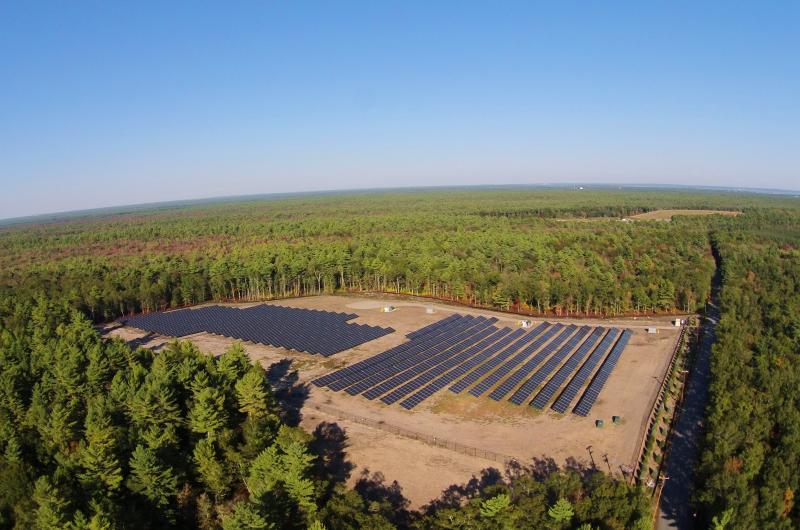Upgrades needed to send solar projects forward
While one new solar energy project started pumping electricity into the grid this month, developers of two more projects must wait for results from an engineering study before starting construction.
In Mattapoisett, a project capable of generating six megawatts of electricity – enough to power 10,000 homes – has been proposed for 16 Crystal Springs Road.
In Marion, a group of residents wants to build a community solar garden on the town’s capped landfill.
The Benson Brook Community Solar Garden in Marion is slated for a 2.4-acre area of the town's former landfill. A fairly new concept, community solar gardens allow residents to purchase electricity at reduced rates.
In May 2014, the Marion Energy Management Committee hired My Generation Energy, Inc. to develop the community garden at Benson Brook Road.
Soon after, the My Generation Energy officials learned that Eversource (formerly NSTAR) could not connect the solar project to the electrical grid without upgrades to a substation near the Crystal Springs Road project.
An important part of the grid’s transmission system, substations transform voltage from high to low capacity or vice versa.
When complete, the projects will send additional electricity to the grid through the Mattapoisett substation.
Eversource spokesman Michael Durand said because of that, the power company must assess the substation. He said the evaluation would likely start this year.
“Known as a cluster study, there is a significant amount of work involved in this engineering evaluation, and it could take several months to complete,” Durand said.
A representative from Bluewave Capital, the solar and wind company developing the Mattapoisett project, said he hopes the study is finished soon.
“We have everything we need to start construction,” Aidan Foley of Bluewave Capital said. “We’re doing our very best to get it online this year.”
Foley is a managing director and the project manager for the Mattapoisett project. The solar farm proposed for Crystal Spring Road is the company’s second project in town. In September, a project that produces three megawatts of electricity was completed on Tinkham Hill Road.
The new project will cover roughly 28 acres of land.
Foley said energy from the Crystal Springs Road solar farm would be marketed and sold to municipalities and other large consumers of electricity.
“There are towns that are saving substantial amounts of money,” Foley said. “Some save hundreds of thousands of dollars each year.”
Waiting for Eversource’s approval is another delay for the Benson Brook Road project that members of the town’s Energy Management Committee first proposed two years ago.
“This is an obstacle we hadn’t anticipated,” committee member Bill Saltonstall said.
In 2013, the committee recommended using the town’s capped landfill as a site for a community solar garden. The project required a zoning change that voters at Town Meeting overwhelmingly approved.
In addition to offering residents an opportunity to purchase renewable energy, Saltonstall said My Generation Energy would lease the land from the town.
The next step for the committee is to secure a post-closure permit from the Massachusetts Department of Environmental Protection (DEP.) The permits are required before any work can be done on capped landfills.
“That shouldn’t be a problem,” said Jennifer Francis, also of the Energy Management Committee. “The [DEP] has approved solar for more than fifty landfills across the state. They want to see capped landfills used for this purpose.”
The Benson Brook array would be the second community solar garden in Marion.
A similar project on County Road went online this month.
Luke Hinkle, the founder of My Generation Energy, Inc., said the company worked hard through a difficult winter to finish on schedule.
While participation in the Benson Brook project is only open to Marion residents, any South Coast Eversource customer may apply for a share of the Sippican Community Solar Garden on County Road.
In both projects, customers would purchase SunRights, essentially an electricity credit. Each SunRight costs $5,000 and guarantees at least $7,200 in “net-metered” credits. Net metering offsets the cost of electricity used by a homeowner with power generated from the garden’s solar panels. The cost of the electricity generated for the grid is deducted from the power bill.
Hinkle said the savings could be even higher due to a recent hike in electrical rates.
Of the 160 SunRights available, 125 have been purchased. With interest high, Hinkle said he expected that anyone else looking to participate would have to wait.
Hinkle said the success of the County Road project is a shining example for future solar projects.
















